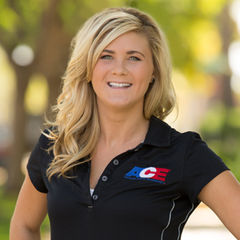This first blog covers vital information about anatomy, which includes the basic structure of the different systems of the body. To be able to discern whether or not this information is going to be important, you need to ask, “How does this apply to train a client?” If there is no practical application, it’s probably a topic where a general understanding is sufficient. If there is a direct application to an aspect of training, it’s probably going to be a topic you want to dive into a little deeper.
Planes of Motion and the Segmented Movements Within Each Plane
Planes of motion and the movements within each plane are essential to understand because it helps us break down movement mechanics. Most exercises are performed within a single plane (except for functional resistance training, which often incorporates multiplanar movements), and any additional movement can potentially take away from the effectiveness of a given exercise. For example, if your client is doing a squat (sagittal plane), you need to pay attention to the position of the knees. The knees are supposed to stay in line with the hip and ankles, but many novice exercisers or those who have underlying tightness or weakness in the hip and thigh muscles allow the knees to drift in (adduction) or out (abduction). As an exercise professional, you want to understand what actions occur in each plane so that you can effectively observe deviations from that plane to correct them. You’ll see this come into play as you’re performing postural and movement assessments or while observing the form of your class or clients. The goal is to help your clients develop the kinesthetic awareness of what proper postural alignment feels like so eventually they can understand how to make these adjustments on their own.
Muscles and Their Actions
Now, thinking back to that practical application, the way this topic is addressed on the exam does not involve the labeling of muscle charts. It’s going to be about applying your anatomy knowledge to the muscles that need to be stretched or strengthened. If you see that your clients looked sort of hunched over (maybe some slight kyphosis and shoulder protraction), you can generally assume that there will be tightness across the chest and weakness across the back. You can address this by incorporating stretches of the chest and strength training of the back muscles (i.e., trapezius and rhomboids). The body always wants to be in that proper postural alignment, but through extended overuse of certain muscles and underuse of opposing muscles, we deviate from that balanced position.
Proprioception – Function of the Muscle Spindles and GTO
Proprioception is the understanding and awareness of where the body is in space in relation to its surroundings. Part of what goes into our muscular control and coordination comes from our musculotendinous receptors (HINT: When there is an “o” in the middle of a word it means “and,” so these are receptors of the muscles and tendons), the Golgi tendon organ (GTO) and the muscle spindles. The muscle spindles are coiled around the muscles and when they sense that muscle being stretched, they cause two things to happen: 1) the muscle being stretched (agonist) contracts to prevent you from going too far too fast in that stretch; and 2) the opposing muscle force (antagonist) is inhibited (prevented from contracting) so that the muscle doesn’t pull us farther into that stretch. After about six to 15 seconds, the GTOs sense that same tension on the muscles and cause the working muscle (agonist) to relax so that you can sink a little deeper into that stretch. The muscles spindles and GTOs go through this cycle to help you stretch safely and effectively; it’s also the reason why, when holding a stretch, you’re usually able to go a little deeper into the stretch than where you started. For more detailed information see here: Autogenic vs. Reciprocal Inhibition GTO’s
Basics of the Cardiovascular System
The cardiovascular, or circulatory, the system is a closed-circuit system composed of the heart blood vessels (arteries, arterioles, capillaries, venules, and veins) and the blood. The blood travels through the body in two distinct circuits: the pulmonary and systemic. The pulmonary circuit takes blood returned to the heart from the body and pumps it to the lungs to be oxygenated. It then returns it to the heart where it embarks on the systemic circuit to deliver that freshly oxygenated blood to the whole body. The heart serves as a pump to drive this blood flow, and each beat has two phases: systole and diastole. Systole is the contraction portion that ejects blood out of the heart and drives it into either the pulmonary arteries or the aorta to continue through the rest of its journey. The diastolic phase is the relaxation portion where the heart relaxes so that each chamber can refill with new blood. With exercise, the heart can become more efficient with each beat, meaning it won’t need to beat as many times at rest.
Basics of the Respiratory System
The respiratory (to respire means to breathe) system replaces oxygen into the blood and removes carbon dioxide (CO2) and is made up of the nose, nasal cavity, pharynx, larynx, trachea, bronchi and lungs. The diaphragm contracts during inspiration (inhalation) and draws air into the lungs, and relaxes during expiration (exhalation), allowing air to be released from the lungs. During rest, the body uses about 5 to 6 liters/minute of air, but during exercise, it can use up to 20 to 30 liters/minute of air to meet the increased demands for oxygen and ridding the body of excess CO2. With exercise, the body’s ability to extract and utilize oxygen from inspired air is enhanced.
Basics of the Digestive System
The digestive system is responsible for extracting nutrients from the foods and beverages that we consume and excreting any leftover waste. It involves six processes: ingestion in the mouth (consuming food/beverages); the movement of food along the digestive tract using involuntary smooth muscle contractions called peristalsis; mechanical preparation of food for digestion (including chewing and churning of the food in the stomach to break it down into smaller pieces for easier digestion); chemical digestion (chemical breakdown in the stomach); absorption of the digested foods into the body for use; and elimination of the indigestible substances and waste leftover. Most of the absorption occurs in the small intestine, but the final digestion of water and salt occurs in the large intestine, leaving semi-solid waste for excretion.
Basics of the Skeletal System
The skeletal system is made of bones and bone is an active, living tissue that provides support, movement, protection, storage, and formation of blood cells. There are four types of bones: long, short, flat, and irregular. Bones have a dense outer layer called cortical bone, which makes up about 75 percent of the skeleton, and a sponge-like inner portion called trabecular bone, which makes up about 25 percent of the skeleton. There are two parts of the skeleton: the axial skeleton, which provides support and protection for the central nervous system (CNS) and includes the skull, vertebral column, sternum and ribs; and the appendicular skeleton, which includes the bones of the upper and lower limbs and the pectoral and pelvic girdles, all of which serve as a means to provide support and movement for the body. When two bones come together (articulate) they form a joint; some joints allow a lot of movement, while others allow very little (if any).
Basics of the Nervous System
The nervous system is comprised of the central nervous system (CNS), consisting of the brain and spinal cord, and the peripheral nervous system (PNS), which contains all other nerves. There are both sensory input and output that allow us to make the appropriate reactions and responses to the stimuli we receive. It’s also responsible for proprioception (see above).
Basics of the Muscular System
The muscular system is responsible for movement, and there are three types of muscles: cardiac, smooth, and skeletal muscle. Skeletal muscle is what acts on the skeleton and causes movement of the body in space. There are two types of muscle fibers: Type I (slow-twitch muscle fiber) and Type II (fast-twitch muscle). Type I muscle fibers rely on aerobic energy production and Type II muscle fibers rely on anaerobic energy production. For more information on the energy production for these muscle types see here.
Basics of the Endocrine System
The endocrine system is made up of glands throughout the body and is responsible for regulating body processes through hormones. How hormones affect the body during exercise are addressed in greater detail in Chapter 2.




 by
by 











